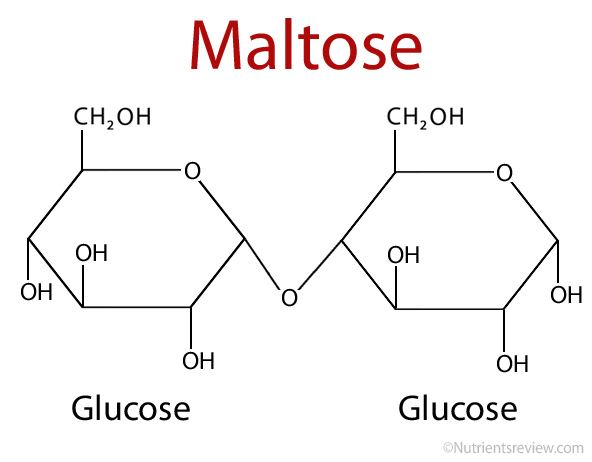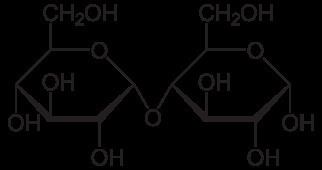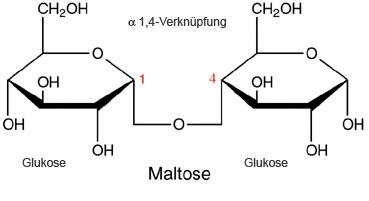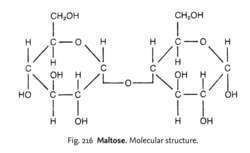Formula C12H22O11 Melting point 102 °C Soluble in Water | Molar mass 342.3 g/mol Density 1.54 g/cm³ Appearance White powder or crystals | |
 | ||
Related IUPAC ID 2-(hydroxymethyl)-6-[4,5,6-trihydroxy-2-(hydroxymethyl)oxan-3-yl]oxyox ane-3,4,5-triol | ||
Disaccharides maltose lactose and sucrose
Maltose (/ˈmɔːltoʊs/ or /ˈmɔːltoʊz/), also known as maltobiose or malt sugar, is a disaccharide formed from two units of glucose joined with an α(1→4) bond, formed from a condensation reaction. The isomer isomaltose has two glucose molecules linked through an α(1→6) bond.
Contents
- Disaccharides maltose lactose and sucrose
- Structure of maltose
- History
- Structure and nomenclature
- Properties
- Intolerance
- References

Maltose is the second member of an important biochemical series of glucose chains. Maltose is the disaccharide produced when amylase breaks down starch. It is found in germinating seeds as they break down their starch stores to use for food, which is why it was named after malt. It is also produced when glucose is caramelized.

Structure of maltose
History

Maltose was discovered by Irish chemist and brewer Cornelius O'Sullivan in 1872. Its name comes from malt, from Old English mealt, of Germanic origin, and the suffix '–ose', a suffix denoting names of sugars and other carbohydrates.
Structure and nomenclature
Maltose is a biomolecule that belongs to the group of carbohydrates within the division of biomolecules into the three main groups: carbohydrates, lipids and proteins. Carbohydrates are composed of carbon, oxygen and hydrogen C, O, H and are either polyhydroxyaldehydes or polyhydroxyketones.
As a group, they are generally divided into monosaccharides, oligosaccharides, and polysaccharides depending on the number of sugar subunits. Maltose is an oligosaccharide, specifically a disaccharide, formed by the union of two glucose units (monosaccharide). Glucose is classified as a hexose because it is composed of six carbons. The two glucoses which compose maltose are cyclized in pyran form and are joined by an O-glycosidic bond through the first carbon (C1) of the first glucose and fourth carbon (C4) of the second glucose, indicated as (1 → 4). The link is characterized as α due to the O-glycosidic bond to the anomeric carbon (C1) being in the opposite plane from the CH
2OH substituent in the same ring (C6 of the first glucose). If the O-glycosidic bond to the anomeric carbon (C1) was in the same plane as the CH
2OH substituent, it would be classified as a β(1 → 4) bond, and the resulting molecule would be cellobiose. The anomeric carbon (C1) of the second glucose molecule, the (C1) that is not involved in an O-glycosidic bond, could be either an α- or β-anomer depending on the bond direction of the attached hydroxyl group relative to the CH
2OH substituent of the same ring, resulting in either α-maltose or β-maltose.
Due to O-glycosidic link, maltose is a disaccharide that can reduce Fehling's reagent. Furthermore, maltose can be obtained by hydrolysis of glycogen or starch, polymers of linked maltoses in position α(1 → 4) and branching in position α(1 → 6). These are very abundant and form a large number of branches. Amylase enzymes produce maltose and limit dextrin. These can be further degraded by maltase enzyme to hydrolyze maltoses as glucoses and they are ready to be degrade and obtain energy in form of ATP.
An isomer of maltose is isomaltose. This is similar to maltose but instead of bonds in position α(1 → 4), the linkage is formed in position α(1 → 6), therefore, glycogen branching is defined by isomaltose.maltose, isomaltose is also a reducing sugar.
Properties
Intolerance
Homopolysaccharides of glucose are broken down by maltase and isomaltase to produce glucose. The lack of the Sucrase-Isomaltase enzyme, one of the four integral glycoproteins, causes sucrose and maltose intolerance and is called Congenital Sucrase-Isomaltase Deficiency. This congenital disorder is most prominent in infancy but can develop later in life. It is caused by a recessive autosomal mutation (mostly SI and SII). Nonetheless, depending on the type of mutation there are certain degrees of intolerance. According to this degree, physicians may decide the amount of starch the patient may have to remain healthy. This intolerance begins when infants begin to eat nutrients that contain starch, mainly containing maltose. One can notice that a patient suffers from this pathology when they have “stomach cramps, bloating, excess gas production, nausea, vomiting and diarrhea. Upper respiratory tract and viral infections are common. These digestive problems can lead to lower than normal weight gain and growth. Possible associations are kidney stones and copper malabsorption.” Further studies have shown that certain patients with different degrees of mutation can actually improve throughout the years, reaching a maximum improvement at ages 3 years and 6 months.
